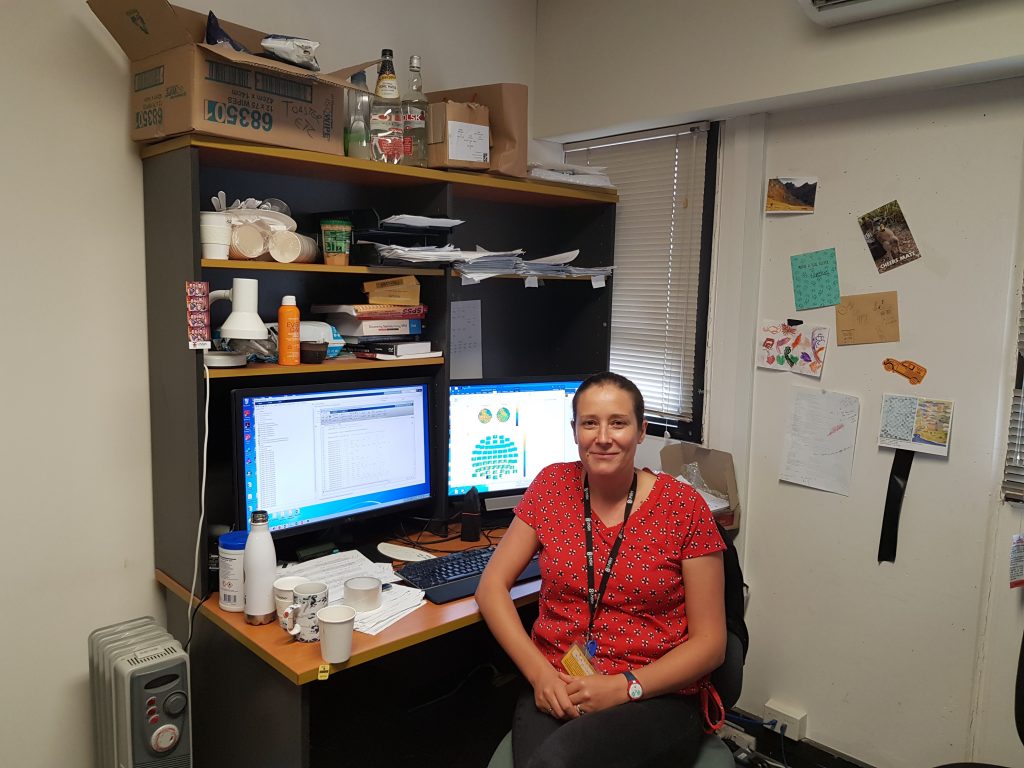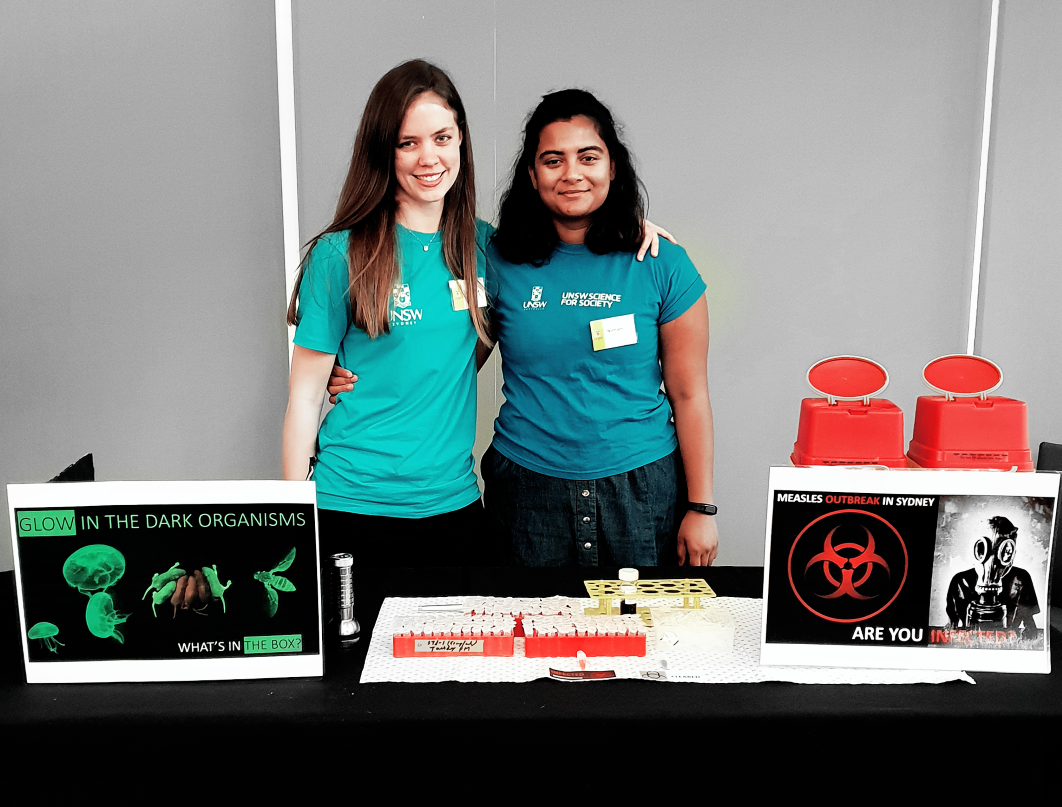By Dr Lisa Nivison-Smith
 Dr Poppy Watson did not always want to be researcher. After a lack-lustre introduction to the world of Psychology at University, she spent the first part of her working life dabbling in sound editing and travelling. Almost a decade later, she gave Psychology another chance and fell head first into the world of research where she now tries to understand how human behaviour changes in response to reward. A mother, beach lover and now UNSW Women in Maths and Science Champion, Poppy believes solutions to major world problems will come from scientists, engineers and mathematicians, and is excited to encourage young girls to pursue a career in STEM.
Dr Poppy Watson did not always want to be researcher. After a lack-lustre introduction to the world of Psychology at University, she spent the first part of her working life dabbling in sound editing and travelling. Almost a decade later, she gave Psychology another chance and fell head first into the world of research where she now tries to understand how human behaviour changes in response to reward. A mother, beach lover and now UNSW Women in Maths and Science Champion, Poppy believes solutions to major world problems will come from scientists, engineers and mathematicians, and is excited to encourage young girls to pursue a career in STEM.
So, what type of ‘scientist’ are you?
I work in the school of Psychology at UNSW as a postdoctoral research associate, so essentially I am a psychology researcher.
What does your current research focus on?
My research examines how learning about reward shapes attention and behaviour. Cues that signal reward are everywhere in our environment. Think about the McDonald’s golden M – over time this symbol has transformed from just another letter to something that is associated with a reward (like tasty burgers!). We are interested in how reward is processed by the brain by different people in different situations because this might explain why some people are more susceptible to addiction-like behaviours such as binge eating and others are not.
Most people think psychology is about lying down in a chair and telling someone your problems. But how do you actually do your psychology research?
We use a lot of technology to track people’s physical reactions and brain patterns. For example, in some of our current experiments, we tell participants that if they can find a specific shape on a computer screen (i.e. a diamond) whilst not looking at reward cues that also appear on the screen, we will give them a financial reward. We then use an eye tracker to see what they actually look at. Although the task sounds easy, our research shows that people find it very difficult to not look at cues that signal reward, even when they are entirely irrelevant for the task at hand. They capture our attention involuntarily because of their association with rewards (such as tasty junk food). We then repeat these experiments but look how different situations like stress or intoxication might reduce our ability to ignore signals of reward. For example, we have the participants undergo a brief but stressful manipulation (i.e. sing a song to the experimenter) or give the participants an acute dose of alcohol before performing the visual search (diamond) task. I’m also studying neural oscillations using electroencephalography (EEG) to examine the extent to which signals of attentional suppression can be seen in the brain during this task.

How did you become a researcher in Psychology? Did you always want to work in science?
I was actually quite disillusioned with Psychology after my undergraduate year and decided not to stay for honours research. I had studied elective courses in sound engineering and sound effects editing during my degree and really loved it so I decided to pursue a career in that instead. I ended up working and travelling through Europe during my 20s – I had some sound editing jobs and also worked in administrative roles at government departments and big pharmaceutical companies.
After eight years I decided to go back to university to upskill myself. I started with a two-year research Masters degree in Brain and Cognitive Sciences and this led to a PhD at the University of Amsterdam. I absolutely loved being back in the academic environment and still do to this day – doing research is the best job I have ever had. I love the whole cycle – reading literature, designing experiments to test hypotheses, programming experimental tasks, testing participants, analysing the data and then writing it up for publication. The frequent international travel to attend conferences is also a great bonus!

Mythbusting time! What are some of the worst stereotypes about Psychology?
People always think that that psychologists are all clinically trained and at parties people often joke that I must be trying to analyse them and “read their mind”. Nothing could be further from the truth! Although I have a PhD in Psychology I have absolutely no clinical training (that is a different career path altogether). Academic psychologists who do research generally know as much as anyone else in the general population about how to read personalities at a party or how to support someone who has mental health issues.
When you are not researching, what do you like to do in your spare time?
I live near the beach so spend a lot of my spare time in the water. Having two small children means that I don’t go out as much as I would like but I do keep my eye on good music gigs happening in Sydney and try to get out regularly to good restaurants.
Why did you join the UNSW Women in Maths and Science Champions Program?
The program is a great opportunity to change the stereotype of what scientists look like and inspire young women to pursue STEM subjects. Students (of any gender) who are good at maths and science should be so excited about their future – so many of the world’s problems are going to be solved by engineers, scientists and technology experts working together. I hate to think that young girls are not encouraged to pursue these fulfilling and amazing careers. The program has also provided a chance for myself to be inspired by female champions who are at later stages in their careers.
Follow Poppy on Twitter
Follow Lisa on Twitter




 We had two main activities planned for the event. The first one was designed to teach the students about the importance of vaccination and how infections could spread across the populations quickly. Each student was given a tube that is meant to represent a sample from their body. They add a chemical indicator into the tube to test if their body is ‘infected’ with measles by observing a colour change. They either received a ‘cleared’ or ‘quarantine’ sticker according to their test results, which they had to wear in plain sight, so that others knew if there was the possibility of contracting measles from them if they have not been vaccinated. The stickers we issued were a big hit! Some of the students who were not ‘infected’ wanted to be so they could also get a ‘quarantine’ sticker and join their friends. We picked measles as our infectious disease as it has been in the news lately due to resurgence of the disease in the United States due to the anti-vaccination movement. It was interesting to talk to the students about the anti-vaxxer movement because it was clear to us that only half of the students knew or heard of the movement and what it meant for public health. We think it is important to raise awareness about serious issues such as these due to the direct impact it may have on their lives.
We had two main activities planned for the event. The first one was designed to teach the students about the importance of vaccination and how infections could spread across the populations quickly. Each student was given a tube that is meant to represent a sample from their body. They add a chemical indicator into the tube to test if their body is ‘infected’ with measles by observing a colour change. They either received a ‘cleared’ or ‘quarantine’ sticker according to their test results, which they had to wear in plain sight, so that others knew if there was the possibility of contracting measles from them if they have not been vaccinated. The stickers we issued were a big hit! Some of the students who were not ‘infected’ wanted to be so they could also get a ‘quarantine’ sticker and join their friends. We picked measles as our infectious disease as it has been in the news lately due to resurgence of the disease in the United States due to the anti-vaccination movement. It was interesting to talk to the students about the anti-vaxxer movement because it was clear to us that only half of the students knew or heard of the movement and what it meant for public health. We think it is important to raise awareness about serious issues such as these due to the direct impact it may have on their lives.
